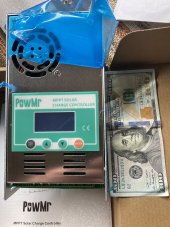12VoltInstalls
life passes by too quickly to not live in freedom
Watched a few videos and read some online. This video in particular seems relevant. Other posts on diysolarforum come up now and again with similar issues and some Australian sites have mentioned this for years.
I’m starting to wonder if - other than the real water ingress issue with MC4s- if some of my multiple cable end and cable swap outs were not necessary because in spite of the water inside the connectors the cutout ‘feature’ has the same symptoms.
I have had the two 140Ah Btrpower batteries on my voltage-controlled 10A charger set at 14.5V for 48 hours. At some point between 26hrs and the 48 hours (I wasn’t here) the amps went to zero. Upon observing this when I got home I turned it up to 14.6 volts and it ran <2minutes rolling down from 8A to zero amps. Good I think.
12hrs later (this morning) they were sitting at 13.8V. Turning on the charger at 14.5V it ran for ~3 minutes starting at 7.x amps and diminishing to zero amps. >>>I am not certain 13.8V is good or not fwiw - I need to learn more.
I have a 200A (might be 300A) 12V Drok shunt to install on cable between a 2000W QZRELB aka ‘Reliable’ psw inverter and will connect my 12V loads at the inverter input cables (so as to capture all discharging loads). I plan to run these batteries down to whatever the untouchable factory BMS’s LVD is to measure capacity.
THAT will resolve that question.
Then I will reconnect the 4215AN with the Equalize set at 1 minute at 14.6V and both the boost/bulk and ‘float’ set to 14.55V
THIS should function properly according to the video posted above; then I will observe charging efficacy. Because if SCC output kWh is less than measured load kWh on good sun days and/or if I observe 10W of solar input (or worst case- have dead batteries) then I will know that the Epever has an irreconcilable intrinsic problem inherent to them. If the Epever does fail out (4215AN model) I will try with the 6420AN again to see if it duplicates the cutout.
If both Epevers fail out (I hope they don’t) everything Epever goes up for sale- some still New In Box.
My ‘radical’ interim solution if the Epevers aren’t redeemable is to order several powrMR 60A SCCs (or maybe Ampinvt) and probably save up some cash for future Victron. PowrMR 60A are only ~$90 and some video creators in the sector have positive opinions of the powerMR products (though mentioning their bottom-shelf status).
I’m starting to wonder if - other than the real water ingress issue with MC4s- if some of my multiple cable end and cable swap outs were not necessary because in spite of the water inside the connectors the cutout ‘feature’ has the same symptoms.
I have had the two 140Ah Btrpower batteries on my voltage-controlled 10A charger set at 14.5V for 48 hours. At some point between 26hrs and the 48 hours (I wasn’t here) the amps went to zero. Upon observing this when I got home I turned it up to 14.6 volts and it ran <2minutes rolling down from 8A to zero amps. Good I think.
12hrs later (this morning) they were sitting at 13.8V. Turning on the charger at 14.5V it ran for ~3 minutes starting at 7.x amps and diminishing to zero amps. >>>I am not certain 13.8V is good or not fwiw - I need to learn more.
I have a 200A (might be 300A) 12V Drok shunt to install on cable between a 2000W QZRELB aka ‘Reliable’ psw inverter and will connect my 12V loads at the inverter input cables (so as to capture all discharging loads). I plan to run these batteries down to whatever the untouchable factory BMS’s LVD is to measure capacity.
THAT will resolve that question.
Then I will reconnect the 4215AN with the Equalize set at 1 minute at 14.6V and both the boost/bulk and ‘float’ set to 14.55V
THIS should function properly according to the video posted above; then I will observe charging efficacy. Because if SCC output kWh is less than measured load kWh on good sun days and/or if I observe 10W of solar input (or worst case- have dead batteries) then I will know that the Epever has an irreconcilable intrinsic problem inherent to them. If the Epever does fail out (4215AN model) I will try with the 6420AN again to see if it duplicates the cutout.
If both Epevers fail out (I hope they don’t) everything Epever goes up for sale- some still New In Box.
My ‘radical’ interim solution if the Epevers aren’t redeemable is to order several powrMR 60A SCCs (or maybe Ampinvt) and probably save up some cash for future Victron. PowrMR 60A are only ~$90 and some video creators in the sector have positive opinions of the powerMR products (though mentioning their bottom-shelf status).
still hoping for further comments on this
Last edited:





